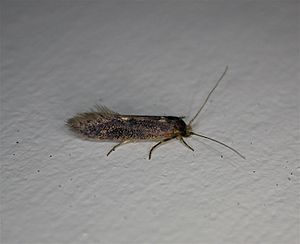Opogona omoscopa facts for kids
Quick facts for kids Opogona omoscopa |
|
|---|---|
 |
|
| Scientific classification | |
| Kingdom: | |
| Phylum: | |
| Class: | |
| Order: | |
| Family: | |
| Genus: |
Opogona
|
| Species: |
O. omoscopa
|
| Binomial name | |
| Opogona omoscopa (Meyrick, 1893)
|
|
| Synonyms | |
|
|
The Opogona omoscopa is a type of moth from the Tineidae family. These moths are often called fungus moths or clothes moths.
Where This Moth Lives
The Opogona omoscopa moth can be found in many parts of the world. It lives in western Australia, New Zealand, and south-east Asia. You can also find it in Africa, from Ethiopia all the way to South Africa. It lives on several islands in the Indian Ocean too.
This moth has even been seen on a very faraway island called Île Amsterdam. This island is part of the French Southern and Antarctic Territories.
Introduced Species
The Opogona omoscopa moth is an "introduced species" in some places. This means it was brought to the United States, Europe, and the United Kingdom by people, not by nature.
About This Moth
This moth is quite small. When its wings are spread out, they measure about 18 to 22 millimeters wide. That's less than an inch!
What the Larvae Eat
The young moths, called larvae, like to eat different kinds of decaying plants. They enjoy rotting wood, cork, and compost. They also munch on parts of plants like rhubarb, gladioli corms, and pineapple roots.
These larvae can also be found on specific "host-plants." A host-plant is a plant that an insect uses for food or shelter. Some of their favorite host-plants include:
- Persea species (like avocado trees)
- Limonium species (also known as sea lavender)
- Cyclamen species (a popular houseplant)
- Thuja species (a type of evergreen tree)
- Fuchsia species (a flowering plant)
- Saccharum species (like sugarcane)
- Quercus suber (the tree that gives us cork)

